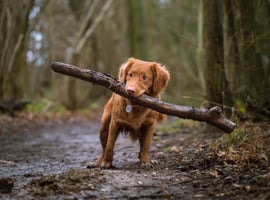Puppies are bundles of fun and joy, but they also require plenty of guidance and love to help them...
The Ultimate Guide to Dachsador Training
Training a Dachsador is no easy task and requires dedication, patience, and a lot of love. This guide will provide you with all the information you need to know about Dachsador training, from early socialisation to obedience classes and more. Read on to learn the best tips and tricks for training a Dachsador puppy and ensuring that they grow up to be a well-behaved and loving companion.
Understanding the Dachsador
The Dachsador is a mixed breed dog, a combination of the Dachshund and Labrador Retriever. They are an intelligent, loyal, and affectionate breed, but can be stubborn and independent at times. It's important to understand their temperament and personality before attempting to train them. Dachsadors can be very loving, but they can also be quite stubborn. They need an owner who is patient and consistent in order to achieve the desired results.
Early Socialisation
Early socialisation is an important part of Dachsador training. This is the process of introducing your puppy to different people, places, and things in order to get them used to different environments. This can help them become more comfortable and confident in new situations. It's important to start socialising your puppy as soon as possible, ideally when they are 8-12 weeks old. Start by introducing them to family and friends, then gradually introduce them to new people, animals, and places. This will help them learn to trust and accept new experiences.
Crate Training
Crate training is a great way to teach your Dachsador positive behaviours and to help them feel secure and comfortable in their environment. It's important to start crate training as soon as possible, as this will help your puppy learn to be comfortable in their crate and begin to associate it with positive experiences. When crate training, be sure to only use the crate for short periods of time, and always provide plenty of positive reinforcement when your puppy is in their crate. This will help them learn to love their crate and view it as a safe and comfortable place.
Obedience Training
Obedience training is an important part of Dachsador training. This is the process of teaching your puppy basic commands such as sit, stay, and come. Obedience training is important for teaching your puppy to follow instructions and to behave in an acceptable manner. Start obedience training as soon as possible, and be sure to use positive reinforcement such as treats or praise when your puppy follows a command. This will help them learn quickly and develop good behaviour habits.
Potty Training
Potty training is an important part of Dachsador training. This is the process of teaching your puppy where and when to eliminate. Potty training can be a challenging process, but with patience and consistency, you can achieve the desired results. Start by taking your puppy outside frequently and providing positive reinforcement when they eliminate in the appropriate area. Be sure to clean up any messes immediately and never punish your puppy for accidents. With patience and consistency, you can help your puppy learn to eliminate in the appropriate area.
Leash Training
Leash training is an important part of Dachsador training. This is the process of teaching your puppy to walk on a leash without pulling or tugging. Leash training can be a challenging process, but with patience and consistency, you can achieve the desired results. Start by introducing your puppy to a leash and providing positive reinforcement when they walk on it without pulling or tugging. Be sure to keep the sessions short and provide plenty of rewards and praise when your puppy is walking properly on the leash.
Training Tips and Tricks
- Be consistent: Consistency is key when it comes to Dachsador training. Be sure to use the same commands, rewards, and punishments every time so that your puppy can learn quickly and easily.
- Use positive reinforcement: Positive reinforcement is one of the most effective tools for Dachsador training. Be sure to provide plenty of rewards and praise when your puppy is behaving properly, and avoid punishing them for any mistakes.
- Be patient: Training a Dachsador can be a long and challenging process, so it's important to be patient. If your puppy is struggling to learn a command, take a break and try again later.
- Be fun: Training a Dachsador should be fun for both you and your puppy. Be sure to make the sessions short and enjoyable, and provide plenty of rewards and praise.
Conclusion
Training a Dachsador is no easy task, but with patience, consistency, and plenty of love, you can achieve the desired results. Be sure to start early socialisation and obedience training as soon as possible, and use positive reinforcement and rewards whenever possible. With the tips and tricks outlined in this guide, you can ensure that your Dachsador grows up to be a well-behaved and loving companion.



